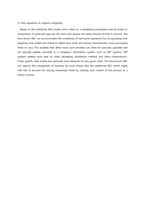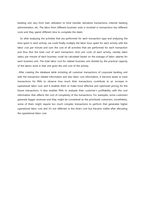Essay Assignment_Alto_MBA_Time drive activity based costing_Prof Teemu Malmi
 등록일 / 수정일
등록일 / 수정일 페이지 / 형식
페이지 / 형식 자료평가
자료평가 구매가격
구매가격
- 2023.02.12 / 2023.02.12
- 5페이지 /
 docx (MS워드 2007이상)
docx (MS워드 2007이상) - 평가한 분이 없습니다. (구매금액의 3%지급)
- 2,000원
최대 20페이지까지 미리보기 서비스를 제공합니다.
자료평가하면 구매금액의 3%지급!
 1
1 2
2 3
3 4
4 5
5
추천 연관자료
- 하고 싶은 말
- 핀란드 Aalto 대학교 MBA 과제
- 본문내용
-
1. What are the main arguments?
1) Traditional ABC model
Over the past decades, lots of companies have utilized a traditional ABC model to manage their limited resources effectively. By employee surveying, this model estimates the percentage of time they spend on certain activity and then assign the resource expenses according to the average percentages they get from the survey. But this model has several problems or limitation to apply it to a large scale of organization.
It’s difficult to implement and maintain the traditional ABC model because it costs lots of money and time specifically when we try to roll this approach out on a large scale for use on an ongoing basis.
Because of the costs of reinterviewing and resurveying, the systems based on this model are updated infrequently, as a result, this model’s estimates of process, product and customer costs soon became inaccurate.
This model also often fails to capture the complexity of actual operations. As the activity dictionary expands, we should either reflect more detail about activities of expand the scope of the model to the entire organization. Often times, such expansion has caused a traditional ABC system to exceed the capacity of generic spreadsheet tools so that this system ends up with taking several days to process one month’s worth of data.
When interviewing and surveying employees about how much time they spend on a list of activities, they invariably report percentages that add up to 100%. Therefore, cost-driver rates are calculated assuming that resources are working at full capacity, namely, the estimated cost-driver rates are usually much too high than reality.
2) The Time-Driven ABC model
Based on the time-driven ABC model, we can directly estimate the resource demands imposed by each transaction, product or customer rather than assign resource costs first to activities and then to products or customers. For each group of resources, estimates of only two parameters are required. First is “the cost per time unit” of supplying resource capacity, and second is “the unit times” of consumption of resource capacity by products, services and customers. At the same time, the new model provides more accurate cost-driver rates by allowing “unit times” to be estimated even for complex, specialized transactions.
Estimating “the cost per time unit” of capacity
Instead of surveying the employees on how they spend their time, companies could directly estimate the practical capacity of the resources supplied as percentage of the theoretical capacity, assuming that piratical full capacity is 80% to 85%. And for more systematic approach, we can review past activity levels and identify the month with the largest number of orders handled without excessive delays, poor quality, overtime, or stressed employees.
Estimating “the unit times” of activities
Next, companies determine the time it takes to carry out one unit of each kind of activity. These numbers can be obtained through interviews or by direct observation. The important point is that we don’t ask about the percentage of time an employee spends doing an activity but ask about how long it take to complete one unit of that activity.
Deriving cost-driver rates
The cost-driver rates can be calculated by multiplying the cost per time unit and the unit times. The calculation of resource cost per time unit forces the company to incorporate estimates of the practical capacities of its resources, allowing the ABC cost drivers to provide more accurate signals about the cost and the underlying efficiency of its processes.
Analyzing and reporting costs
Time-driven ABC enables companies to report their cost on an ongoing basis in a way that reveals both the costs of a business’s activities as well as the time spent on them. The report highlights the difference between capacity supplied and the capacity used. Companies can review the cost of the unused capacity and contemplate actions to determine whether and how to reduce the costs of supplying unused resources in subsequent periods. In some cases, the information can save companies that are considering expansion from making unnecessary new investments in capacity because they find that they’re underutilizing their capacity.
Updating the model
자료평가
-
아직 평가한 내용이 없습니다.
회원 추천자료
- Essay Assignment_Alto_MBA_Having trouble with your strategy Then map it_Prof Teemu Malmi
- Essay Assignment_Alto_MBA_Financial Control System of the Volkswagen Group_Prof Teemu Malmi
- Essay Assignment_Alto_MBA_Reinventing Performance Management_Prof Teemu Malmi
- Lecture Note_AI Based Strategic Management_Prof Dong Sung, Cho
- 영국, 중국, 미국, 한국의 사회적 기업 사례
오늘 본 자료
더보기

최근 판매 자료
- 프리미엄아이스크림 시장과 나뚜루 전략적 방향 분석
- 스티븐 폴 잡스의 변혁적 리더십 성공사례
- 아랍에미레이트 항공 분석 보고서
- [마케팅] [마케팅원론]삼성 노블카운티(Noble County) 실버마케팅 사레분석(A+리포트)
- [경영정보시스템, MIS] 경영정보시스템(MIS)의 발전과정, 기능과 경영정보시스템(MIS)의 계획절차, 운영요소 및 경영정보시스템(MIS)에 대한 제언(사례 중심)
- [MIS, 경영정보시스템] 세븐일레븐 재팬 7-Eleven Japan 사례분석
- 국내 화장품 산업의 정의, 발전과정, 특징, 현황, 전망
- 미디어매체를 통해본 상상속 연애와현실연애,연애와현실,성역할,매체와현실
- 세계화 시대의 국제매너 개념, 나라별 특징, 매너, 사례, 예절, 예절, 관리, 역할, 기법, 시사점, 나의견해, 총체적 조사분석
- 국가별 매너 ,개념, 에티켓, 나라별 특징, 매너, 사례, 예절, 예절, 관리, 역할, 기법, 시사점, 나의견해, 총체적 조사분석
저작권 관련 사항 정보 및 게시물 내용의 진실성에 대하여 레포트샵은 보증하지 아니하며, 해당 정보 및 게시물의 저작권과 기타 법적 책임은 자료 등록자에게 있습니다. 위 정보 및 게시물 내용의 불법적 이용, 무단 전재·배포는 금지됩니다. 저작권침해, 명예훼손 등 분쟁요소 발견시 고객센터에 신고해 주시기 바랍니다.









